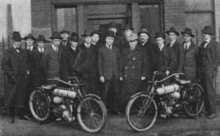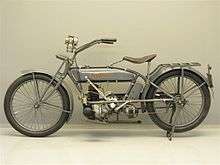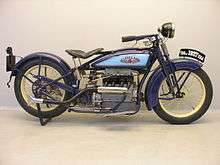Cleveland Motorcycle Manufacturing Company
The Cleveland Motorcycle Manufacturing Company, sometimes called Cleveland Motorcycle, was a motorcycle manufacturer in Cleveland, Ohio from 1902 to 1905 and again from 1915 to 1929.[1][2]
 | |
| Industry | Motor vehicle |
|---|---|
| Founded | 1915 |
| Defunct | 1929 |
| Headquarters | Cleveland, Ohio , USA |
| Products | Motorcycles |
Two-stroke singles
The first Cleveland of 1915 had a 221 cc (13.5 cu in)[3] displacement two-stroke single-cylinder engine with a longitudinal crankshaft orientation, necessitating a worm drive to turn the axis of rotation of the drive to the transmission by 90°.[1] The transmission was a two speed with a sprocket turning a chain final drive. Besides driving the transmission, the engine's countershaft extended back to drive a magneto that hung in front of the rear wheel.[1] In 1920, the motorcycle's weight increased from the addition of fenders, a larger fuel/oil tank, and in 1921 the seat was enlarged, along with a still larger fuel/oil tank, and a battery was added. The displacement was increased to 269 cc (16.4 cu in) to handle the increased weight of 195 lb (88 kg) from these changes.[1][3] During World War I, US forces used the Cleveland as a base courier.[4]



Four-strokes, four cylinders, and failure

In 1924, two years after buying out Reading-Standard, Cleveland replaced their two-stroke engine with a 21.5 cubic inches (352 cc) four-stroke single-cylinder engine.[5] In 1925 they released a motorcycle with a 36.5 cubic inches (598 cc) T-head four-cylinder engine designed by L. E. Fowler.[6][7] With a smaller engine than rival four-cylinder motorcycles by Henderson and Ace, Cleveland's first four-cylinder motorcycle did not sell well.[5][6] In 1926, Cleveland replaced the Fowler engine with a new design by E. H. DeLong.[6][8] The new engine had an inlet-over-exhaust valve configuration[6][9] and a displacement of forty-five cubic inches.[5][8] The displacement was increased to sixty-one cubic inches the following year.[5][6][8]
By 1928 Cleveland had financial problems. That year, the company offered itself for sale to Harley-Davidson. Harley-Davidson considered the offer, as Cleveland's new four-cylinder motorcycles offered a ready-made competitor to Indian's Ace-based fours, but rejected it in favor of developing their own four.[10]
In 1929 Cleveland announced their Tornado model, with a lowered frame and seat height, lightweight pistons, larger valves, and a higher compression ratio.[6][8][9] A Century model, with a guaranteed top speed of one hundred miles per hour, was announced.[6][8]
A few months after the Wall Street Crash of 1929, after building only a few prototypes of the Century, Cleveland went out of business.[8]
References
- Rafferty, Tod (2001), The Illustrated Directory of Classic American Motorcycles, Prospero Books div. of Chapters Inc., pp. 49–49, ISBN 1-55267-118-6
- "America on the Move | Cleveland motorcycle". National Museum of American History. 2008-10-24. Retrieved 2009-08-14.
- Siegal, Margie (May–June 2017). "The Same, But Different: 1927 Cleveland 4-45 and 4-61 Motorcycles". Motorcycle Classics. Retrieved June 21, 2017.
- Ayton, Cyril (1983) [First published 1979], The History of Motor Cycling (Revised ed.), London: Orbis Publishing, p. 84, ISBN 0-85613-517-8
- Wilson, Hugo (1995). "The Directory of Motorcycles". The Encyclopedia of the Motorcycle. London: Dorling Kindersley. p. 269. ISBN 0-7513-0206-6.
- De Cet, Micro (2003), The Illustrated Directory of Motorcycles, MotorBooks International, pp. 102–105, ISBN 978-0-7603-1417-3, archived from the original on 2013-12-30, retrieved 2012-09-30
- Wilson, Hugo (1995). "The Directory of Motorcycles". The Encyclopedia of the Motorcycle. London: Dorling Kindersley. p. 271. ISBN 0-7513-0206-6.
- Wood, Bill, ed. (March 1992). "Classics: 1929 Cleveland Century". American Motorcyclist. American Motorcyclist Association. 46 (3): 87. ISSN 0277-9358. Retrieved 2012-09-30.
In 1926, Cleveland took a step toward that goal with the Model 4-45 (four cylinders, 45 cubic inches), designed by E. H. DeLong.
- Wilson, Hugo (1995). "The A-Z of Motorcycles". The Encyclopedia of the Motorcycle. London: Dorling Kindersley. p. 45. ISBN 0-7513-0206-6.
- Tyson, Bob (15 November 2005). Harley-Davidson Memories: The Golden Age of Motorcycling. Turner Publishing. pp. 66–67. ISBN 978-1-59652-046-2. Retrieved 2012-09-30.
Cleveland was in financial trouble, and had offered to sell out to the Milwaukee firm.
External links
- The Cleveland Motorcycle (1919) - 17-page promotional brochure including photographs, pricing, specifications, and additional information on the motorcycle.
| Wikimedia Commons has media related to Cleveland Motorcycle Manufacturing Company. |